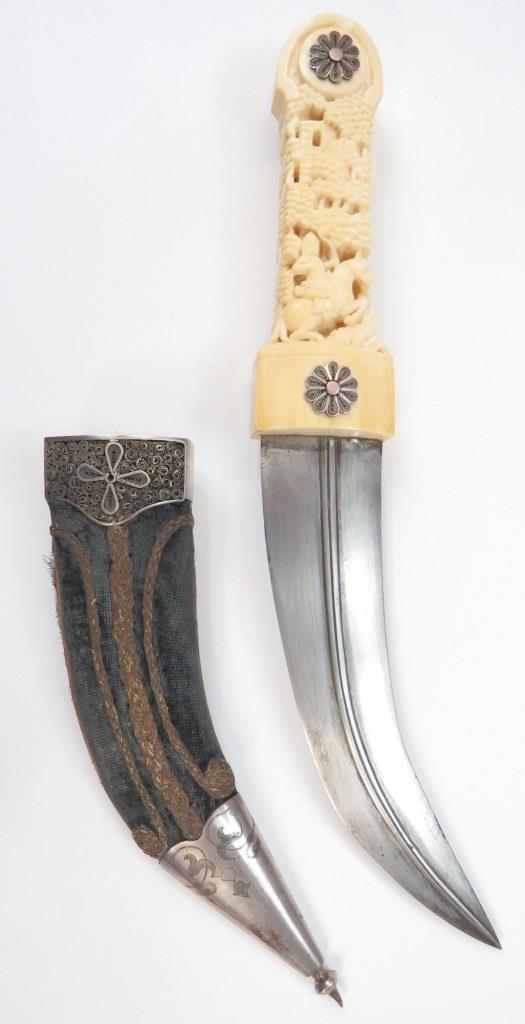
On the Persian Shamshir and the Signature of Assad Allah By Oliver Pinchot c February, 2002 and October, 2015 May be reproduced by written permission of the author only.
At the beginning of the 17th century, a type of sword blade known as the shamshir, or Lion’s Tail,
appeared in Persia, which rapidly supplanted earlier forms. [1] The shamshir’s popularity spread
throughout Persia and within decades, demand for the elegantly-curved blade reached unprecedented
heights throughout the Near East, Asia and Eastern Europe. Its popularity endured well into the
twentieth century.[1]In time, the fame of the shamshir came to be linked to a single smith, Assad Allah
Isfahani, whose name was as widely recognized in the Dar al-Islam as that of Benvenuto Cellini in
Western Europe. Surviving examples of blades bearing the name Assad Allah justify this fame; virtually
always forged of high quality damascus steel, they are found in mounts distinctive of regions as diverse
as Poland and Bukhara.[2] [2] However, as L. A. Mayer aptly observes:
Asad Allah Isfahani, by general consent of Eastern and Western opinion, the finest of all Persian swordsmiths, and
without any doubt the mostfamous of them all, is unquestionably also the most elusively mysterious. To the best of my
knowledge, no contemporary chronicle mentions him as a living being, no details of historical value are known about
his life or his work…[3]
The purpose of this paper is to consider whether the name Assad Allah actually refers to a master smith
of 17th century Isfahan, to a folk hero who grew out of Persian lore, or to ‘Ali, also known in Shi’ite Iran
as Assad Allah, whose position in Shi’ism is paramount. Further, it is to determine how his name gained
such singular prominence in both East and West, as evidenced by the disproportionately large number
of sword blades which bear it. Factors including Persia’s economic and political circumstances and
policies under Abbas I, and those of the early Qajars, will be considered. Popular theories regarding
Assad Allah will be examined, as will the formal evolution of blades, and the signatures and symbols
found upon them; each of which is attributed to the “most elusively mysterious smith.”
The significance of the sword in the Dar al-Islam
Even a cursory review of the importance of the sword in Islam reveals a marked preference which can
hardly be overstated. From the advent of the Prophet until the end of the last century, the sword held a
position of dual importance, both as the weapon par excellence of the ghazi, and the preeminent
spiritual symbol in the realm of futuwwa or knightly virtues.[4] Though repeating firearms ultimately
superseded the sword’s importance on the battlefield, it has retained its symbolic emphasis to the
present.[5]
Consistent with pre-Islamic traditions in the Near East and Central Asia, the sword was an item of
considerable veneration in the time of the Prophet,who is reputed to have placed particular importance
on weapons captured in battle. Particular swords have long been associated with him, together with other
items of military equipment.[6] The Arab tradition of naming swords also precedes the advent of Islam.
Such names often referred to an important battle or place of manufacture, though more descriptive and
poetic names were quite popular; these imbued weapons with a decidedly animistic character. A
particularly well-documented example is the Prophet’s weapon Samsama (Sharp One).[7] The most
famous, however, was a sword used by Muhammad at the Battle of Badr in 624. This sword, called Dhu’l
Faqar (Possessor of Spines), was later given to his son in law, Ali ibn al-Talib. It holds an especially
prominent position in Islamic, and particularly Shi’ite, military and spiritual traditions, as does ‘Ali. Due
in great part to diverse interpretations of it lore and name, Dhu’l Faqar was conventionalized into several
unusual iconographic representations, the only unifying characteristic among which is an oddly
bifurcated tip. The proverb, La fata illa ‘Ali, wa la sayfa illa Dhu’l Faqar (There is no hero like ‘Ali, and no
sword like Dhu’l Faqar), is found on swords and daggers throughout the Dar al-Islam.[8] Interestingly, the
names of Arab tribal chiefs are recorded together with those of their swords in some period chronicles,
indicating the esteem in which swords were held, both as temporal and spiritual weapons during that era.
[9] Several swords inscribed with the names of the early caliphs are still preserved in the Reliquary at
Topkapi Palace, Istanbul. These swords juxtapose simple, early, fighting blades and lavish, mid-sixteenth
century Ottoman mounts, some of solid gold, which serve to reinforce their value as holy relics.[10]
Persia under Abbas I
Civil and political circumstances in Persia in the latter-sixteenth century were the greatest causes of
expanded trade and the export of luxury consumer goods to Europe and Central Asia. Primary among
these were carpets, textiles and finely embellished weapons.[11] In 1588, Abbas I acceded to the Peacock
Throne, at the lowest ebb of the Safavid dynasty. It fell to him to reassert the power of the monarchy, as
well as to reestablish and maintain Persia’s borders. He was seventeen, and promptlylearned the
consequences of kingship- Persia was threatened in the east by the nomadic Uzbeks and the Mughals,
and to the west by the Ottoman Empire. Unable to fight on both fronts simultaneously, Abbas had little
choice but to settle a hasty peace with the most powerful of his opponents;; he was compelled to cede
large portions of Western Persia, including Azarbaijan, to Sultan Mehmet III in 1589/90. This allowed
Abbas a respite of several years, during which time he undertook to dissolve existing Persian tribal
alliances and construct an entirely new state military. Under the former feudal system, soldiers were
compensated either by a small percentage of acquired loot or paid by the petty tribal leaders for whom
they fought. The Shah’s new army or Ghulam (slaves) were the descendents of Georgian, Circassian and
Armenian immigrants. Converted to Islam, trained and maintained on a regular salary by the shah, the
ghulam army represented a novel development among sixteenth-century Islamic states.
Abbas’ reign was marked by an arduous, though effective, transformation of Persia, both political and
economic. Period paintings invariably portray intelligence and discernment in his features; even the
painter ofthe Mughal propaganda piece Jahangir’s Dream succeeded in conveying, despite Abbas
supplicating expression, his characteristic cleverness. [12] Between 1589-1599, Abbas defeateded the Uzbeks
and Mughals, and by 1623 had succeeded in driving the Turks back across their former borders,
occupying Baghdad in the process. Most importantly, he took the city of Karbala. Now situated in
Central Iraq, Karbala represents a site of primary importance to Shi’ite Muslims, as the place where the
Imam Hussayn was martyred, c. 680.
Origins of the shamshir and the use of damascus steel
As noted above,Abbas was very much a military innovator. It is possible he is responsible for the
distinctive design of the shamshir blade with which this paper is concerned; certainly he popularized it.
[13] The shamshir was a simplification of earlier forms; elegant, lightly curved and single-edged, with a
continuous taper from midpoint to tip. Abbas wears precisely this type of sword in several portraits
representing him in his middle years, though it does not appear in earlier paintings.[14] In fact, the same
shamshir is invariably represented- it is readily identifiable by its uniquely beaked or hooked hilt, called
a karabela by Western historians. The origin of this hilt, and the etymology of its name, form the basis
for considerable confusion and debate.[15] If, however, these portraits can be positively dated after 1623,
the year in which Abbas conquered the Shi’ite shrine, I would argue that the term ‘karabela’ is a simple,
though garbled, transliteration of Karbala, where Abbas is likely to have encountered this form of hilt.[16]
Robert Elgood also suggests that Abbas may have “adopted [it] as a memento of this campaign.”[17] [3]
Following the suppression of the Uzbeks in 1598, Abbas relocated the Persian capital from Qazvin to
Isfahan. With characteristic patience, he transformed Isfahan into Persia’s most important commercial
and cultural center, as well as an architectural showcase: Isfahan, it was said, is half the world. An
aggressive drive to fund the new military by increasing his state’s revenue through foreign trade, and an
equally pressing need for political alliances against the Ottomans, compelled Abbas to welcome virtually
all European visitors to his new capital. Sir Roger Stevens notes,
And so we have, passing through Isfahan or settling there for long periods, a motley band of Europeansambassadors and adventurers, monks and mountebanks, traders and travellers, including combinations of each. Some could scarcely read or write, others wrote volumes…[18]
In 1601, Sigismund III of Poland sent an Armenian merchant, Sefer Muratovitch, on a commercial
mission to Isfahan with instructions to procure “rugs woven with the royal arms, as well as costly fabrics,
tents and weapons, specifically sabre blades of watered steel.” (emphasis added). This Muratovitch did,
including a finely chased and gilded silver shield with which Sigismund was ultimately interred.[19] Thus,
through trade, the shamshir found its way into the West.
Isfahan had long been a center of arms production in Persia; iron ore was mined in the region from at
least the eight century.[20] Persian sword blades had enjoyed an excellent reputation for the quality of
their damascus (Pers: johar or jewel) for many centuries prior to the period under discussion. Damascus
steel or wootz billets from the Khorassan desert region in northwest Persia were imported to Isfahan and
other smithing centers such as Fars and Kufa, where through an arduous process, they were forged into
sword blades.[21] Due to its chemical composition, wootz exhibited remarkable physical properties: it
held a very sharp edge, and did not dull easily as softer steels did, yet it remained flexible under strain,
unlike hard steels, which could hold an edge but often snapped as a result. Further, it displayed unusual
surface markings similar to moiré silk when bathed in a mild acid solution. Another common term for
wootz, watered steel, may refer to these surface markings, or to the etching process itself. Gradually,
Persian smiths learned to judge the quality of their work by the damascus patterns which appeared on
the finished surface. Overrseveral several centuries, the craft was refined to an art; as smiths learned to duplicate
recognizable patterns in the steel, their surface markings came to be associated with the highest-quality
blades. As the demand for fine blades beyond Persia’s borders grew, merchants acquired an educated eye
for the patterns they displayed, and were thus able to appraise the qualities of a particular piece without
specific technical knowledge. Finally, the distinctive visual impact of a damascus blade conveyed its
quality clearly and effectively to prospective buyers, without the need for verbal communication. By the
beginning of the nineteenth century, the popularity of damascus blades had become widespread
throughout bazaars of Asia and the Near East, to the extent that numerous forgery techniques appeared.
These attempted to imitate the intricate surface markings of damascus upon ordinary steel, with varying
degrees of success.[22] Particular damascus patterns became well-known: among them, the Lover’s Knot,
inwhich a series of small “knots” or whorls covered the surface of the blade, and Qum, or “gravel,” in
which the surface appeared like tiny scattered pebbles. By far the most notable pattern, however, was the
Kirk Narduban, or “Prophet’s Ladder,”in which twenty to forty regularly-spaced transverse strips or
“rungs” ran the entire length of the blade.[23] [4]
The legendary smith
Paradigms regarding Assad Allah and the blades which bear his name remain largely unchanged from
the time they were framed, during the Victorian era. These fall into three groups: First, that a small
number of exceptional blades actually constitute the work of Assad Allah, though no specific test for
determining this exists in any of the literature. Rather, one finds lyrical descriptions, “…his blades are of
the most beautiful sweep and balance, besides being of very finely watered steel…”[24] Secondly, that the
signature of Assad Allah on lesser examples constitutes a much larger category of blades, duplicated by
numerous makers upon their own work over a period of several centuries, and intended as an indicator
of high quality, rather than the name of the smith Assad Allah, per se. Lastly, the appearance of the
(in)famous signature on inferior examples is discounted as simple forgery. These notions persist, as
Mayer quips:
The number of sabres and scimitars bearing [the] name [Assad Allah] is legion, so much so that it is difficult to resist
the temptation…to say that of the three hundred swords of which approximately he could have made during his lifetime, at least five hundred have found their way to Western collections alone.[25]
The question of Assad Allah’s existence has been very broadly interpreted, ranging from George
Cameron Stone’s assured, yet unsupported, statement, “Assad Allah [was] the most celebrated of the
Persian swordsmiths. He lived in Ispahan in the time of Shah Abbas, 1587-1628… [and] is the best known
ofthe Persian sword makers…” to Mayer’s decidedly skeptical reference to the “most elusively
mysterious” smith.[26] It is A.K.S. Lambton, however, in her research on guilds from Safavid through
Qajar era-Persia, who makes the single valid historical reference to the existence of Assad Allah:
Shah Abbas is said to have received a helmet from the Ottoman sultan, who offered a sum of money to whoever could
break the helmet with a sword. No one was able to do this until a certain Asad, a sword-maker, made a sword with
which he cut through the helmet.[27]
The reward conferred upon the smith named Assad by Shah Abbas, and its far-reaching effects, will be
considered below.
The literal meaning of the Arabic name Assad Allah is Lion of God. It was not an uncommon given name
during the time of Abbas and is still popular in Iran today. More importantly, however, it was one ofthe
sobriquets by which ‘Ali, a figure of virtually unparalleled importance among Shi’ites, was popularly
known in Persia.[28] Though no connection between Assad Allah and the Imam ‘Ali via the cognomen
Lion of God appears in the literature, the relationship becomes clear iconographically with the increase
in sword production of the late eighteenth and early nineteenth centuries.
Inscriptions on Islamic blades and the Assad Allah signature
Given the high occurrence of inscriptions on Islamic weapons, it is clear that considerable importance
was attached to them. The nature of these inscriptions, and the general quality of workmanship lavished
upon them, suggest that these words and signs were intended for both public and private consumption.
Irene Bierman has shown that the raiment of Fatimid rulers and their retainers contained referential
verses designed to inform and dazzle a public audience.[29] There is no reason to doubt that fine
weapons played a similar role, given their almost habitual appearance as sartorial accoutrements in
Persian, Ottoman and Mughal miniatures.[30]
Inscriptions occur on most forms of edged weapons within the Dar al-Islam, though primarily on swords
and daggers. Texts range from Qur’anic quotations and exhortations, through various forms of poetry, to
purely referential data, including the names of a maker or owner and the date of manufacture on
acquisition. Examples display information recorded in Arabic, Persian, Ottoman, Urdu, Russian and
Serbian languages and characters, among others in their respective regions. More rarely, inscriptions in
both Arabic and local scripts occur.[31] Both Shi’ite and Sunnite examples often bear phrases glorifying
the Fourth Caliph, ‘Ali ibn al-Talib, and in the Ottoman Empire as well as in Persia, poetic couplets in
Persian were especially popular.[32] A particular group of Eastern European blades, including Austrian,
Hungarian, Polish and Russian, bear marks with clear iconic referents to Arabic, including “arabesque”
designs, series of pseudo-Arabic characters and numerals enclosed in cartouches.[33] These are clearly
imitative of the Arabic numerals often found inscribed on Islamic blades, corresponding to a specific
Sura or incised within a Baduh or talismanic square.[34] Inscriptions found on blades made during the
early period tend to be short, referential, and simply-incised, while medieval and later examples often
bear lengthy Qur’anic quotations inlaid in gold or silver.[35] Very rarely, swords may include dynastic
genealogies, which are helpful in placing forms and types within a chronological framework.[36]
Shamshir blades of the seventeenth century are often unmarked, thougha percentage bear the incised
name of the smith and the ruler under whom the blade was made. This information is contained on the
right side of the blade, within a symmetrical cartouche or cartouches, the upper one generally an ogival
spheroid and the lower a polygon. These cartouches are generally found at the right forte or base of the
blade; the characters and borders are often inlaid in gold or brass. Alternatively, inscriptions are executed
in relief, containing the same information, or one of the 99 Attributes of God, generally those regarding
war or victory. Occasionally, the expression, ‘O ‘Ali!’ is found. During this period, the shamshir is typified
by elegant simplicity and is generally without embellishment. Dated examples of seventeenth century
blades are extremely uncommon. Anthony North of the Victoria & Albert Museum, London, suggests a
simple and reasonable method of dating unmarked blades:
“The dating of Persian blades without the assistance ofinscriptions is very difficult. In general, the very broad heavy
blades with slight curvature are likely to date from the 16th to 17th century period. Persian blades of later date tend
to be both lighter and shorter. Several examples of these light, short blades bearing the names of 18th-century owners
are recorded.”[37]
L. A. Mayer located and catalogued a surprising number of shamshir blades (164) which bear the
signature of Assad Allah, in European and Russian collections. Many are also marked, Abbas, bande e
shah e vilayet, however only sixteen, a little less than 10%, actually bear dates; these fall between the years
811 a.h. (1408) and 1223 a.h. (1808). Ten blades date between 1018 (1609) and 1127 (1715), within about a
century of each other. Only two of these dating during the reign of Abbas (1018 [1609] and 1031 [1621]).
Eight blades fall within a 41-year span from 1085 a.h. (1674) to 1127 a.h. (1715), representing the highest
frequency of dated pieces (50%).[38] My own research shows similar results.[39] It is clear from these
figures that the majority of signed blades were made well after the reign of Shah Abbas, during which
period Assad Allah reputedly lived. By far, the latest known example is cited by Elgood. It appears to be
of good form, and displays a ladder-pattern damask. Signed Assad Allah Isfahani, in the lower cartouche,
it is also dated, in the Gregorian calendar but expressed in Arabic numerals, 1) (1921.)[40] [5]
The enormous demand for Persian blades both in Persia and abroad resulted in great increases in
production at such centers as Khorassan, Qazvin and Isfahan in the late eighteenth and nineteenth
centuries. During this period, the elegant form of the shamshir is very rarely found. Persian smiths
reverted to producing an appreciably heavier and more complex type of blade, replete with fullers,
grooves and false edge,which had been popular prior to the reign of Abbas.[41][5] Too, the familiar
signature, ‘Amali Assad Allah, began to evolve into a simple pictogram, representing a stylized lion
contained within a circular cartouche.[6] Several examples have come to light which may be considered
intermediate in form, these include the Arabic term ‘amali or the name Assad engraved within the body
of the lion as well, confirming its symbolism.[7] The transition from written word to pictogram indicates
a distinct marketing shift in late-eighteenth century Persia, which coincides with the Qajar rise to power.
[42] From what had begun as a limited output of blades, made to order for a small, aristocratic
patronage, makers now expanded production to supply a much different segment of Persian society, one
which was far more numerous, and correspondingly less literate. We may conclude, from the generally
lower quality of these blades, in which forging, finishing and embellishment all suffer by comparison
with earlier examples, that the art of the individual swordsmith in Persia had given way to
commercialism.
As a result of this shift, the value of an earlier shamshir of the finest black damask remained quite high.
Sir William Ouseley, secretary ofthe British ambassador to the court of Fath ‘Ali Shah Qajar between
1810-1812, records in June, 1811:
[Prince] Husein ‘Ali Mirza… sent Sir Gore Ouseley… a handsome sword, and a belt ornamented with emeralds, all
large but none free from blemishes…. the sword and belt were, together, estimated at seventy or eighty [pounds]; a
greater price than this is frequently given for a good blade alone, especially if an old Kara Khorasani, or if
made in the time of Sha’h Abba’s by Ased Allah [sic] of Isfahan .[43] (emphasis added)
Persian damask blades were still greatly prized among bedouin Arabs a century later. Elgood mentions
the unification of the ‘Aniza tribes under the Amir of Rwala in N. Arabia during the late 19th and early
20th centuries, who traded at Damascus and Baghdad. The Czech scholar Alois Musil traveled with them
and astutely recorded the prices of various types of sword blades offered in the bazaars, “daban [plain?]…
$4.50-$9; …’agami [Eastern Iraq], of gray steel…$4.50- $36; the gawhar [johar, Persian wootz] made of
cast steel from Horasan, [Khorassan], $135…”[44] The observations of Ouseley and Musil serve to
illustrate two important points: first, that the bedouins continued to show a strong preference for Persian
blades, and valued them considerably over those of plain steel, and that the inevitable goal of mass
production begun by Persian smiths a century before had been reached: greater sales through an
appreciable decrease in the price per unit.
The reward of the shamshirsaz
It remains that the name Assad Allah is found on many blades. We may discount the notion of imitation;
a sufficient number of blades signed by other smiths, whose very obscurity gives currency to their
individuality-Mahmud Qazvini, Mu’alim Misri, and others, ranging from Altar to Zaman, are known by
a blade or two, thanks to the efforts of Mayer and others. Forgery is a possibility, albeit a limited one,
given the stringent nature of Persian guilds, and other considerations.[45] That the words Assad Allah
represented a trademark found on fine blades, as has long been held, is plausible, though redundant- the
very purpose of a visible damascus pattern was to convey the high quality of the work itself. Finally, the
theory that a small but superlative group of blades comprise the true work of Assad Allah represents a
fantasy on the Orientalist model, which cannot be seriously considered. Let us turn again to A.K.S.
Lambton:
“In Qajar times also, certain guilds… including…sword-makers (shamshirsaz) were… exemptfrom taxation.
Tradition alleges that this exemption goes back to the reign of Shah ‘Abbas…”[46]
As quoted above, “a certain Asad” forged a sword which clove the helmet sent to Abbas by the Turkish
sultan, thereby winning the contest. Such japes were common among Islamic monarchs: Isma’il I,
founder of the Safavid dynasty and Abbas’ ancestor, had made a similarly-deprecating gesture toward
the Ottoman sultan Selim I.[47] Thus, the implication would not have been lost on Abbas. As Lambton
observes,
Shah Abbas was delighted and remitted the tax of the sword-makers. In memory ofthis event the sword-makers
assembled once a year at the grave ofAsad, the shamshirsaz, at Sichan near Isfahan. This practice was still current in
1937.48]
The swordsmiths of Isfahan were exempted from income tax for over 300 years. This brings two
possibilities to light: first, that the appearance of Assad Allah’s name on blades served to commemorate
his considerable contribution to the guild. Secondly, that the government or guild itself required that his
name be indited upon each blade for purposes of tax record-keeping. Therefore, the origins of a practice
which began, either as an act of commemoration or an accounting measure, passed into history, and the
inclusion of the famous signature ultimately became amatter of tradition.
Conclusion
Lambton offers the single viable primary reference to the existence of Assad Allah in the time of ‘Abbas,
in citing the yearly gathering of swordsmiths at his grave, which continued until after WWII.[49] Though
it may be argued that this too, is a matter of tradition is secondary; it remains that the perceived
existence of Assad Allah provided lifetime tax-exempt status for the entire swordsmith’s guild, dating
from at least the beginning of the Qajar dynasty. Despite its questionable historicity, the name Assad
Allah was clearly associated with fine sword blades in Persia by the late 17th century, as is well-supported
by the percentage of dated blades found in that period. This reputation, acquired over generations,
became irrevocably ingrained in the public consciousness. As a result, blades bearing Assad Allah’s name
achieved fame beyond Persia’s borders long before they were ever seen there. Initially, supply must
rarely have been equal to demand, as examples found in foreign mounts are often richly embellished.
[50] As we have seen, the trade process was accelerated through Abbas’ capital at Isfahan, where it
continued throughout the latter 17th and 18th centuries. Under the Qajars, the process was effectively
commercialized, based upon the considerable number of examples which survive. These are
recognizable by a vague absence of form, a low quality of decoration and embellishment, and ageneral
sense of hasty crafting. [51]
The remarkable popularity of Assad Allah blades during the Qajar era, throughout Persia, the Near East
and Central Asia, then, was the result of careful exploitation of an established name. Despite the reduced
quality of the product, clever marketing in a form which was readily recognizable (i.e. through the use of
the lion pictogram), proved exceptionally effective, particularly among the illiterate. The quality of Assad
Allah blades produced during the Qajar era also reflects the gradual supplanting of edged weapons by
repeating firearms, and the dissipation of the quasi-mystical reverence in which swords had formerly
been held. In regions where the sword remained an important spiritual device and primary weapon, as
among the bedouin Arabs discussed above, the demand for Persian blades remained consistently high.
Seen in this light, the appearance of a finely damasked shamshir blade dated 1921 becomes a legacy,
rather than an anomaly.
NOTES
[1] Robert Elgood, The Arms and Armour of Arabia (London, Scolar, 1994), 29.
[2] The terms damascus or watered steel are used here in describing a crucible steel which contains
between 1.2-1.8% carbon, from which the blades under discussion were forged. It is Indian or Persian in
origin; the process by which it was produced was known in India by 200 bce, [J.C. Bhardwaj, Aspects of
Ancient Indian Technology, (Delhi: Motilal Banarsidass, 1979), cited in L. Figiel, On Damascus Steel
(Miami: Atlantis, 1991), 22]. However, the term damascus is a Western one, after the trade center in which
Europeans first encountered weapons made of this material. Damascus steel and watered steel are now
generally applied to any patterned steel.
[3]L. Mayer, Islamic Armourers and Their Works (Geneva: Kundig, 1962), 26.
[4] H.S.K. Sabzawari, Futuwat Namah-yi Sultani, (Chicago, Kazi, 2000), Jay R. Crook, trans., 341 and
passim.
[5] Robert Elgood, The Arms and Armour of Arabia (London, Scolar, 1994), 31. Elgood cites Thomas
(1930) and Thesiger (1959), both of whom reported on the Qara bedouins of S. Arabia, among whom
swords played an important (though not primary) role during the circumcision ritual.
[6] A. R. Zaky, Medieval Arab Arms, in R. Elgood, Islamic Arms and Armour (London: Scolar, 1979), 203.
[7] Ibid. Samsama’s lineage was traced to the region of ‘Ad in Southern Arabia. It was acquired by the
Ummayad caliphs and the Abbasids after them. It is no longer mentioned in chronicles of the ninth
century.
[8]J. Hathaway, The Forgotten Icon: The Sword Zulfikar in Its Ottoman Incarnation, unpublished, 5.
Cited with the kind permission of the author.
[9] A. R. Zaky, Medieval Arab Arms, in R. Elgood, Islamic Arms and Armour (London: Scolar, 1979), 203.
[10] Ibid.
[11] Z. Zygulski, Islamic Arms in Polish Collections, Ibid, 215.
[12] S.C. Welch, Imperial Mughal Painting, (N.Y.: George Braziller, 1978). Work of Abu’l Hasan, 1618-1622.
Freer Gallery of Art, Smithsonian Institution.
[13] G. F. Laking, Oriental Arms and Armour, (London: Clowes, 1964) 6-9. There are several very fine
swords which qualify as Persian shamshirs in the Wallace Collection, London. Labeled ‘Abbasi,’ these
were collected in situ by the collections’ founders beginningg in the latter 18th century. Conveniently, the
regions of origin of many of the items, as well as their local names, were recorded when they were
acquired, and it is clear that the term Abbasi is a nisba of Abbas. However, in N. India ‘Abbasi seems to
have been applied to several forms of sword in addition to the shamshir. It is therefor likely to have
referred to weapons of high quality rather thanaparticular form.
[14] Cz. Jarnuszkiewicz, Szabla Wschodnia I Jej Typu Narodowe (London: Anykwariat, 1973), 117-18, PL. 21,
22. Earlier Persian paintings uniformly represent a distinctly Turkic form of sabre, the kilic. To my
knowledge, no clear representation of the shamshir occurs in paintings prior to the portraits of Abbas
noted above. His son and successor, Shah Safi, is shown wearing what is probably the same sword, in a
painting in the Hermitage Collection, St. Petersburg, dated 1633, as is his grandson, Abbas II (r. 1642-67)
in an unreferenced portrait pictured in G. Gurney, Kingdoms of Asia, the Middle East and Africa (New
York: Crown. 1986). 162.
[15] J. Ostrowski and W. Bochnak, Polish Sabres: Their Origins and Evolution, in Art, Arms and Armour
(Chiasso: Acquafresca, 1979), 233.
[16] The popularity of the karabela hilt in Poland was such that military scholars have often ascribed it a
Polish provenance in the absence of evidence to the contrary. Likewise, the term has been applied
indiscriminately to many different types of sabre there, though its etymology, other than a longoutdated (and coincidental) association with the Italian words, cara bella (dear beauty), remains both
“unexplained, [and] groundless…” (Ostrowski and Bochnak, 238) Ostrowski and Bochnak concede that
the “earliest known examples in Poland” were acquired after the Siege of Vienna in 1683 (Ostrowski and
Bochnak, 233), though many sources continue to represent the karabela as an exclusively Polish weapon.
Elgood’s Arms and Armour of Arabia is a notable exception.
[17] Robert Elgood, The Arms and Armour of Arabia, 15.
[18] Sir R. Stevens, European Visitors to the Safavid Court, in The Journal of Iranian Studies, (Harvard,
1974) Volume VII, 3-4, 421.
[19] Z. Zygulski, Islamic Arms in Polish Collections, Ibid, 215.
[20] J.W. Allan, Persian Metal Technology,(London: Ithaca, 1979), 66.
[21] Ibid, 86.
[22] L. Figiel, On Damascus Steel, (Miami: Atlantis, 1991), 24. The author notes the wax resist process,
which was popular in both Europe and the Near East.
[23] The term Kirk Narduban appears to be another case of mistransliteration from the Turkish Kirk
(forty) Merdeven (steps or stairs).
[24] George C. Stone, A Glossary of the Construction, Decoration, and Use of Arms and Armor (N.Y.: Jack
Brussel, 1961), 77.
[25] L. Mayer, Islamic Their
[26] George C. Stone, A Glossary of the Construction, Decoration, and Use of Arms and Armor, 77.
Stone’s effort was a monumental one. Compiled between the 1890s and the 1930s, it still represents the
standard reference for Islamic and Indian weapons.
[27] A.K.S. Lambton, Islamic Society in Persia, orig. pub. 1954 (London: Variorum,1980), 25.
[28] P. Tamavoli, Lion Rugs: The Lion in Art and Culture of Iran (N.Y.: TransBook, 1985), 2.
[29] I. Bierman, Writing Signs: The Fatimid Public Text, (L.A.: UC, 1998), 122.
[30] S. Blair & J. Bloom, The Arts and Architecture of Islam 1250-1800 (New Haven: Yale, 1994), 28, 60,
210, passim.
[31] A.Astvatsaturian, Orujiye Narodov Kavkaza (Moscow: Khobbikniga, 1995), 105, passim.
[32] C.Thubron, The Venetians, (Alexandia: Time Life, 1980), 118. A late-sixteenth century Turkish naval
sabre is inscribed in gilt naskh characters, “If you seek security, stay ashore…”
[33] E.Wagner, Cut and Thrust Weapons (London: Spring, 1967), 73. A series of quasi-Arab numerals are
shown which the author interprets primarily as astrological signs.
[34] L.A. Mayer, Islamic Armourers and Their Works. (Geneva: Albert Kundig, 1962), 6. The baduh is a
talismanic square which is ruled off in a grid pattern. Each box in the grid contains an Arabic numeral or
character which bears a numerological value. It is found on Berberjewelry as well as swords and daggers
from the Arab Peninsula and Mughal India. There appears to be no distinction in its use between Shi’ites
and Sunnites.
[35] Z. Zygulski, Islamic Arms in Polish Collections, 206. An Arab sword of typical symmetrical form in
the Topkapi collection is inscribed with the name of ‘Umar ibn Al-Aziz, an Umayyad caliph (d. 720) and
the date 100 a.h./719 a.d.
[36] A. North, Swords of Islam, 140-41, in M. Coe ed., Swords and Hilt Weapons (London: Prion, 1996). A
sabre belonging to Shah Tahmasp, Abbas’ grandfather, in the Victoria & Albert Museum, London, is
inlaid along the spine with the Safavid geneology. This is a heavy sabre of complex section which was
replaced by the shamshir in Abbas’ time.
[37] A. North, An Introduction to islamic Arms and Armour (London: HMSO, 1985), 32.
[38]L. Mayer, Islamic Armourers and Their Works (Geneva: Kundig, 1962), 27. Mayer further lists 60
blades publicly and privately held, which are datable by ruler, 45 published and 43 unpublished blades,
which bear only the name Assad Allah, with neither date nor ruler’s name.
[39] Of forty-six shamshir blades I catalogued in private American collections, only fifteen were signed,
eight with the name Assad Allah, of which six included the name of Shah Abbas. Only one was actually
dated (1604).
[40] Robert Elgood, The Arms and Armour of Arabia, 29.
[41] This type of blade represents the revival of a medieval form of sword called the Kalachuri.
Introduced byvarious Central Asian nomadic groups between c. 900c.e. and 1100 c.e.,the Kalachuri was
rapidly adopted throughout the Near East and Western Asia. Beyond stylistic neoclassicism, Persian
blades produced in the nineteenth century of Kalchuri-form likely had a distinct ethnic significance for
Persia’s Turkic enclaves, including Azaris and Turkmen, as well as for the Qajars themselves, who, like the
Safavids, were of Turkic origin. The shamshir apparently retained popularity among the Persian nobility,
it is the only type of sword with which they are represented in period paintings. Most 19th century
Persian shamshirs bear 17th and 18th century blades, given their form. The shamshir did remain in
production in the Ottoman Empire, N. India and among the bedouin Arabs until after the turn of the
century.
[42] P. Tanavoli, Lion Rugs: The Lion in Art and Culture of Iran, 3. The Shir-e Khorshid, or Lion and Sun.
became the Qajar dynastic crest, in emulation of European models, and remained the Persian state
emblem until recently. The lion was also an important icon in pre-Islamic Persia.
[43] Sir W. Ouseley, Travels in Various Countries of the East; More Particularly Persia, (London, Rodwell
& Martin, 1821), 211. In 1811, the British Pound was still equivalent to a Sovereign, or .2354 troy ounces of
fine gold. At a rate of – $1,100 per ounce at the present time (based upon an average ofof prpices from the
years 2004-2014,) the Sovereign would currently be worth about $260. Therefore, if as Sir William
Ouseley notes, “a greater price than this [70-80 pounds] is frequently given for a good blade alone,
especially if an old Kara Khorasani, or if made in the time of Sha’h Abba’s by Ased Allah of Isfahan,” a
good vintage shamshir blade would typically have brought amounts of $18,200.00- $20,800.00, in
contemporary terms. I am indebted to the Alhambra Coin Center, Alhambra, CA., for assistance in
establishing the value of the British Pound in 1811.
[44] Robert Elgood, The Arms and Armour of Arabia, 29, citing A. Musil, Manners and Customs of the
Rwala Bedouins, American Geographical Society, New York, 1928. Musil was a Catholic priest, daring
traveler, photographer,,an Arabic linguist of note and, by British accounts, an Ottoman agitator during
WWI.
[45] First, the skill of smithing, or forging, represented a specialty unto itself, and is distinct from
chiseling or engraving, which involved different skills and tools, and probably different guilds as well. I
have catalogued several swords embellished with engraving and chiseling; individual sections of which
were clearly done by different hands, suggesting the probability that, as in other arts, apprentices did the
lesser work- some showed considerable variations in skill. It was further necessary that a signature be
chiseled or incised upon a blade before it was heat-treated (which task falls within the realm of the smith
once again) otherwise the steel became too hard to work easily.
[46]A.K.S. Lambton, Islamic Society in Persia, 26.
[47]Robert Elgood, The Arms and Armour of Arabia, 21. Shah Isma’il sent Selim I an elaborately
decorated sabre, just as an overlord would do to show approval of a vassal.
[48]A.K.S. Lambton, Islamic Society in Persia, 26.
[49] Ibid.
[50] Robert Elgood, Islamic Arms and Armour (London: Scolar, 1979), 136-147.
[ Desdne the gener alny mass-dronnced nature or Qajar-era Diades, examdies are knowin in whe
quality of form, damask, and chiseled motifs are of far higher quality than average. These superior
blades are invariably distinguished by the addition of a short, chiseled jot beneath the lion’s tail.This jot
is virtually unnoticeable on cursory examination, and thus may have served as a mark of special quality
to the merchant; it may also have indicated the product of a particular shop. Its anatomical placement
seems to reflect a wry witticism as well. These higher-quality blades are invariably longer, with a more
finely-developed profile which approximates that of the original kalachuri more closely. Fullers and
grooves are more carefully cut and finished, the damask is generally of Qum, rather than Kara Khorrasan
grade, and the chiseled motifs, consisting of a Qur’anic passage and the phrase, O Fulfiller of Needs! are
well calligraphed and evenly executed. [8]
Bibliography
Allan, J.W. Persian Metal Technology. London: Ithaca, 1979.
Art, Arms and Armour. Chiasso: Acquafresca, 1979.
Astvatsaturian, A. Orujiye Narodov Kavkaza. Moscow: Khobbikniga, 1995.
Bierman, I. Writing Signs: The Fatimid Public Text, L.A.: UC, 1998.
Blair, S. & Bloom, J. The Arts and Architecture of Islam 1250-1800 New Haven: Yale,1994
Coe, M., ed. Swords and Hilt Weapons. London: Prion, 1996.
Elgood, Robert. The Arms and Armour of Arabia. London: Scolar, 1994.
Figiel, L. On Damascus Steel. Miami: Atlantis, 1991.
Gurney, G. Kingdoms of Asia, the Middle East and Africa. New York: Crown, 1986.
Hathaway,J. The Forgotten Icon: The Sword Zulfikar in Its Ottoman Incarnation, unpublished.
Jarnuszkiewicz, Cz. Szabla Wschodnia I Jej Typu Narodowe. London: Antykwariat, 1973.
Laking, G.F. Oriental Arms and Armour, London: Clowes, 1964.
Lambton, A.K.S. Islamic Society in Persia, London: Variorum,1980.
Mayer, L. Islamic Armourers and Their Works. Geneva: Kundig, 1962.
North, Anthony. An Introduction to Islamic Arms and Armour. London: HMSO, 1985.
Pinchot, Oliver. Arms of the Paladins: The Richard R. Wagner Jr. Collection of Fine Eastern Weapons.
Woonsocket: Mowbray. 2014.
Sabzawari, H.S.K. Futuwat Namah-yi Sultani. Chicago, Kazi, 2000. Jay R. Crook, trans.
Stone, George C. A Glossary of the Construction, Decoration and Use of Arms and Armor. N.Y.: Jack
Brussel. 1961.
Tanavoli, P. Lion Rugs: The Lion in Art and Culture of Iran. N.Y.: TransBook, 1985.
Thubron, C. The Venetians, Alexandria: Time Life, 1980.
Wagner, E. Cut and Thrust Weapons. London: Spring, 1967.
Welch, S. C. Imperial Mughal Painting, N.Y.: George Braziller, 1978.
Zygulski, Z. Islamic Arms in Polish Collections. Warsaw: Krajowa Ajency, 1982.
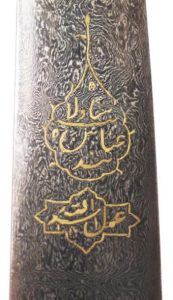
Fig 2 Assad Allah signature
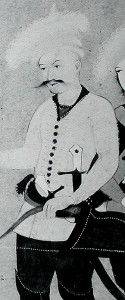
Fig 3a Abbas
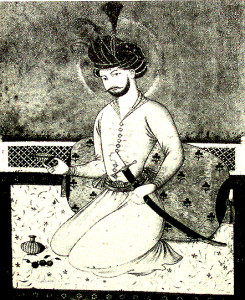
Fig 3b Abbas II
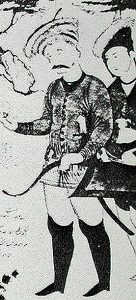
Fig 3c Shah Safi
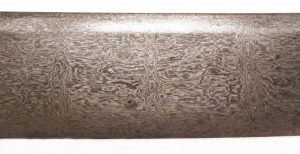
Fig 4 Ladder pattern
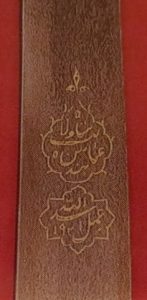
Fig 5 Assad Allah blade dated 1921

Fig 6 Qajar saber
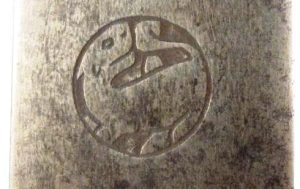
Fig 7a Lion cartouche
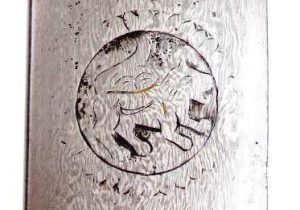
Fig 7b Lion inscribed with Assad Allah name

Fig 8 Lion with jot mark



